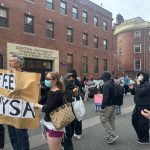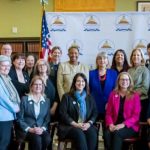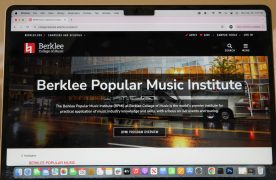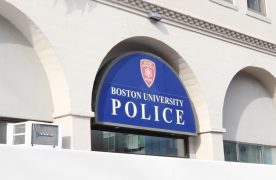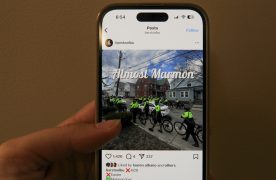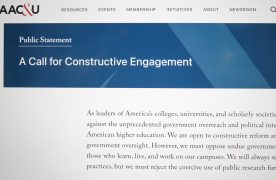As diseases spread faster across borders, a team of scientists, engineers and public health experts launched a first-of-its-kind, open-source global surveillance platform to detect emerging biothreats.
The Biothreats Emergence, Analysis and Communications Network, or BEACON, officially launched April 24 during an introductory conference at Boston University Center for Computing and Data Sciences. The platform is based at Boston University’s Center on Emerging Infectious Diseases and developed in partnership with the Hariri Institute for Computing and Data Sciences at BU and HealthMap at Boston Children’s Hospital.
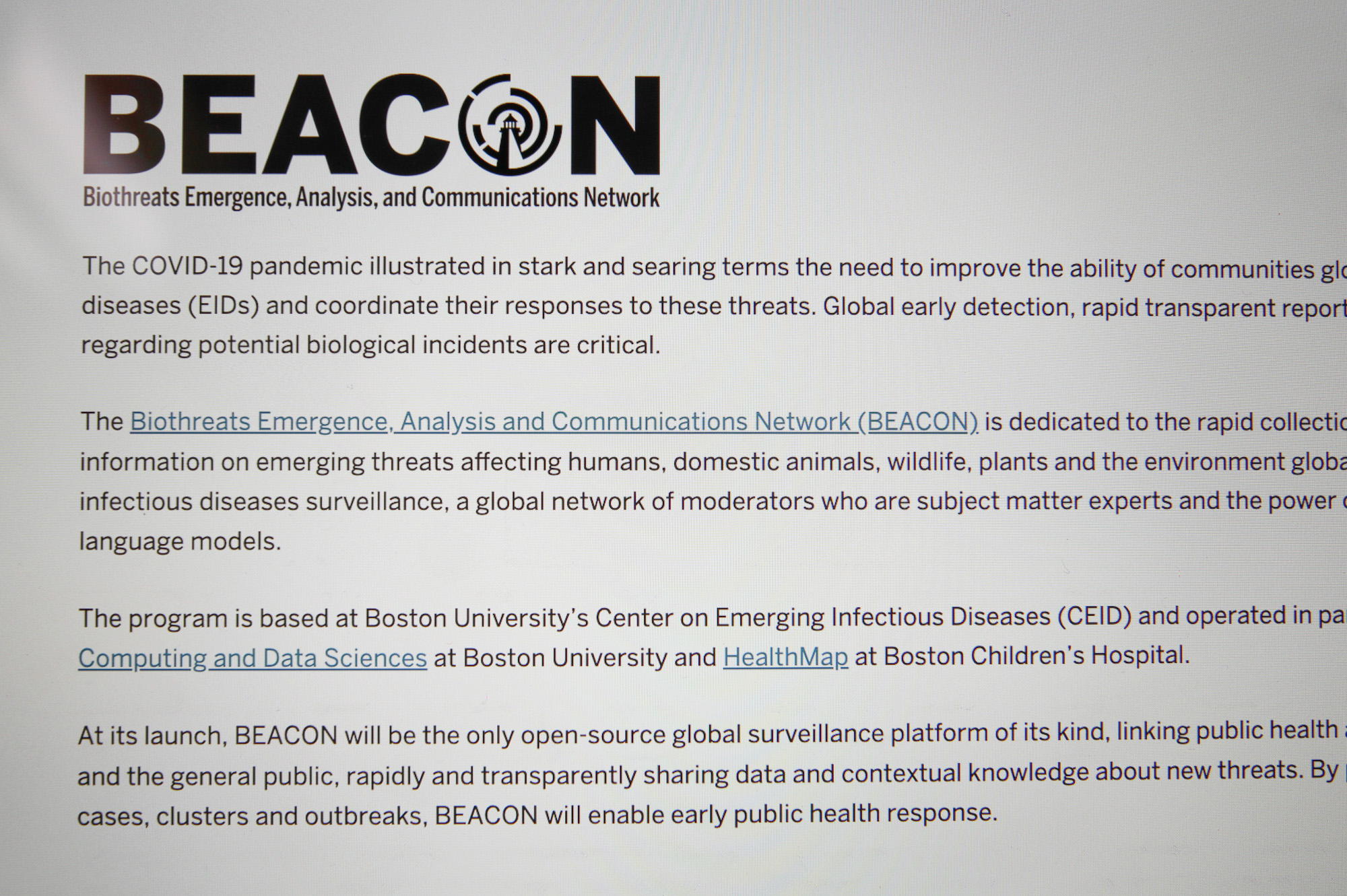
BEACON is designed to provide near-real-time surveillance of emerging biothreats — from human and animal disease to threats affecting plants and the broader environment.
“BEACON is not involved in responses, but what the hope is is that it connects that detection and that response together through reporting,” said Nahid Bhadelia, CEID founding director and BEACON lead director and co-founder, during the launch event. “That may seem like a simple problem, but getting accessible, fast, near-real-time analysis of threats is critical.”
The platform is led by three co-directors — Chief Innovation Officer at Boston Children’s Hospital John Brownstein, Infectious Diseases Physician Britta Lassmann and BU Professor of Engineering Ioannis Paschalidis — alongside Bhadelia.
Recent advances in artificial intelligence presented an opportunity to modernize surveillance systems, Brownstein said.
“What we’ve seen is the massive rise in AI tools [and] large language models, so there was a real opportunity to take some of the principles and data that our system’s HealthMap collected,” he said. “We can leverage the best-in-class AI tools, especially what exists here at BU and Hariri, but also take advantage of human experts.”
BEACON stands apart as the “only open-source infectious disease surveillance platform of its kind,” said Cassandra Kennedy, communication and outreach associate at CEID.
“It is basically as close to real time as we can get,” Kennedy said.
Unlike many existing surveillance programs, BEACON’s open-source, apolitical nature aims to ensure neutrality, said BEACON Program Manager Emily Goldsmith.
“Because we’re not tied to a specific government, there’s an ability to report in a more … neutral way,” Goldsmith said. “That fills a need in the surveillance world to have things be apolitical.”
Kennedy said BEACON’s data-driven approach ensures it remains unbiased.
“What we’re presenting is truly only based on data,” she said. “It’s going to be a very global network, so it’s not taking into account any one country or region’s needs above another,”
The platform’s goal is to serve as a trusted, accessible resource for public health officials, researchers and the public to respond more quickly to emerging threats.
“COVID highlighted very clearly how this is a part of our world, and that we need more systems, better systems to be able to track and share information quickly,” Goldsmith said. “The faster you can see what’s happening, the faster you can respond and keep things from spreading.”
However, BEACON is “not guaranteed to be successful,” Former BU President Robert Brown said as he opened the conference with a speech.
“It will only be successful if it is globally open and becomes a public and trusted platform for information on infectious disease,” Brown said. “It must give fair and mutual access to its data, hopefully to support equitable deployment of healthcare resources. We are dedicated to creating that kind of environment.”
Along with Brown’s opening remarks, the April 24 launch event featured remarks from leaders in global and public health, including Jeremy Farrar, chief scientist at the World Health Organization, and Robbie Goldstein, commissioner of the Massachusetts Department of Public Health.
Bhadelia and Paschalidis demonstrated how the platform’s software works, which was built by the Software & Application Innovation Lab at BU’s Hariri Institute.
BEACON was a “natural fit” for SAIL’s expertise, said SAIL Director William Tomlinson.
The platform’s software SAIL has been the “primary driver of the BEACON back-end system,” said Greg Frasco, associate director of engineering at SAIL.
This “back-end system” handles the technical infrastructure that processes incoming data, powers the website and supports BEACON’s AI-assisted workflows. It also enables subject matter experts, or SMEs, to edit and finalize reports in multiple languages using a large language model tailored to BEACON’s needs, Frasco said.
Frasco explained that the machine learning tools initially filter out irrelevant health-related news that doesn’t align with BEACON’s mission. Then, large language models, or the LLM, extract essential information, which is transformed into draft reports. These drafts are further refined and verified by SMEs before they are published.
“The LLM allows the people to be more efficient with their time, rather than filling in every exact detail. It’s just verifying that it’s correct and being able to pass it to the next person in the line,” Frasco said. “It’s like another assistant on the team that’s knowledgeable and always there.”
Frasco said working on BEACON has been meaningful in today’s political environment.
“[It’s a] very inspiring, impactful project to work on during these times, especially since every day in our current political climate looks very different,” Frasco said. “It’s nice to show that people are working on important things still.”
Following the demonstration, Brownstein led a panel discussion on global health and AI’s role in disease surveillance.
Brownstein said the event emphasized the urgent need for better systems to address outbreaks and misinformation.
“We have challenges in misinformation. We have challenges in outbreaks, both domestically and internationally, and there is an information gap,” he said. “In a moment in time where the general public and public health is scrambling because they don’t have enough data, there’s an opportunity to add this new source of information.”
Bhadelia closed the event by calling on the broader community to get involved.
“Success of something like BEACON only happens when it’s all of us,” she said. “It’s not just the BEACON team. It’s not just public health departments. It’s not just public health programs and researchers. It is the student clinicians. It is regular citizens that see signals in their communities.”
Looking ahead, the BEACON team envisions expanding beyond human diseases to include animals and plant health.
“Our longer-term vision is that we’re going to not just be looking at human diseases but also in animal diseases and eventually plant diseases,” Goldsmith said. “We’re looking kind of holistically at what it means to be doing surveillance on health.”
Brownstein said BEACON’s beta version is just the beginning.
“What we have now, today, is a beta platform with a very poor set of tools,” he said. “We want to improve the ability for our subject matter experts to interact with the system, improve our automation when it comes to the AI tool and create more features on the website so that people can access the data in different ways.”
Goldsmith said BEACON will become a “go-to resource globally,” crediting the team’s extraordinary development pace for its rapid progress.
“We have all these different people who really care, and they’re building off of what they did in the past,” Goldsmith said. “I’ve never seen something move so fast and actually go from an idea, a concept, to something that’s going to be with the public in a year.”
Photo Co-Editor Holly Gustavsen was a photographer at the BEACON launch event. She was not involved in the writing, reporting or editing of this article.


